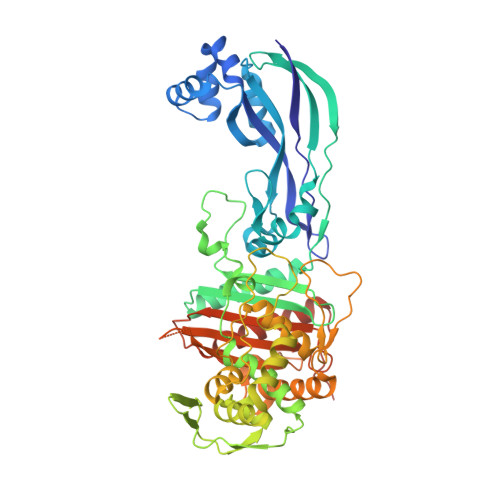Influence of the alpha-Methoxy Group on the Reaction of Temocillin with Pseudomonas aeruginosa PBP3 and CTX-M-14 beta-Lactamase.
Sacco, M.D., Kroeck, K.G., Kemp, M.T., Zhang, X., Andrews, L.D., Chen, Y.(2019) Antimicrob Agents Chemother 64
- PubMed: 31685462
- DOI: https://doi.org/10.1128/AAC.01473-19
- Primary Citation of Related Structures:
6UN1, 6UN3, 6UNB - PubMed Abstract:
The prevalence of multidrug-resistant Pseudomonas aeruginosa has led to the reexamination of older "forgotten" drugs, such as temocillin, for their ability to combat resistant microbes. Temocillin is the 6-α-methoxy analogue of ticarcillin, a carboxypenicillin with well-characterized antipseudomonal properties. The α-methoxy modification confers resistance to serine β-lactamases, yet temocillin is ineffective against P. aeruginosa growth. The origins of temocillin's inferior antibacterial properties against P. aeruginosa have remained relatively unexplored. Here, we analyze the reaction kinetics, protein stability, and binding conformations of temocillin and ticarcillin with penicillin-binding protein 3 (PBP3), an essential PBP in P. aeruginosa We show that the 6-α-methoxy group perturbs the stability of the PBP3 acyl-enzyme, which manifests in an elevated off-rate constant ( k off ) in biochemical assays comparing temocillin with ticarcillin. Complex crystal structures with PBP3 reveal similar binding modes of the two drugs but with important differences. Most notably, the 6-α-methoxy group disrupts a high-quality hydrogen bond with a conserved residue important for ligand binding while also being inserted into a crowded active site, possibly destabilizing the active site and enabling water molecule from bulk solvent to access and cleave the acyl-enzyme bond. This hypothesis is supported by the observation that the acyl-enzyme complex of temocillin has reduced thermal stability compared with ticarcillin. Furthermore, we explore temocillin's mechanism of β-lactamase inhibition with a high-resolution complex structure of CTX-M-14 class A serine β-lactamase. The results suggest that the α-methoxy group prevents hydrolysis by locking the compound into an unexpected conformation that impedes access of the catalytic water to the acyl-enzyme adduct.
- Department of Molecular Medicine, University of South Florida, Tampa, Florida, USA.
Organizational Affiliation:
















